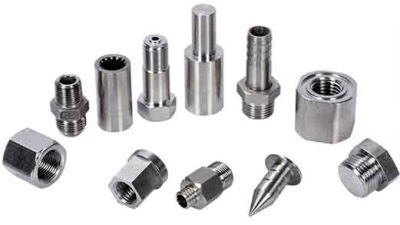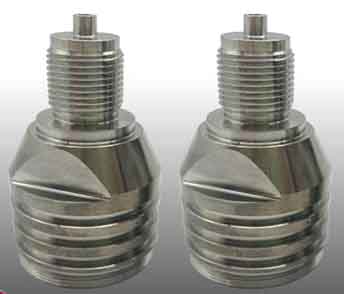Ongelmat CNC-sorvauksessa ruostumattoman teräksen kierteessä ja vastatoimenpiteet
CNC-sorvauskierteen pinnan karheus on liian huono. Yleisin ruostumattoman teräksen kierteiden CNC-sorvauksessa havaittu ilmiö on: suomumainen aaltoilu ja veitsen pureminen. Syyt näihin ilmiöihin ovat:
(1) Kierteen kääntötyökalun molempien sivujen välyskulmat ovat liian pienet, ja leikkaustyökalun kahden sivun ja takakierteen pinnan välinen kitka heikentää koneistettua pintaa. Käsittelyn aikana on otettava huomioon kierteen kiertokulman vaikutus molempien reunojen todelliseen vapaakulmaan.
(2) Kierteen kääntötyökalun kallistuskulma on liian pieni ja leikkuureuna ei ole tarpeeksi terävä. Lastuja ei voida leikata tasaisesti, mutta ne ovat osittain puristuneet tai repeytyneet irti, jonka täytyy saada langan pinta olemaan erittäin karkea. Kun etukulma on liian suuri, terän lujuus heikkenee ja sitä on helppo käyttää, siru, ja lävistää veitsi, mikä todennäköisemmin aiheuttaa tärinää ja aaltoilua langan pinnalle. Siksi, sopiva kallistuskulma tulee valita ruostumattoman teräksen eri materiaalien mukaan. Konsentroitua rikkihappoa kestäviä ruostumattomasta teräksestä valmistettuja kierteitä sorvattaessa, tulee käyttää pienempää kallistuskulmaa kuin 2Cr13 ruostumattomasta teräksestä valmistettujen kierteiden sorvaus. Kääntötyökalun molemmilla puolilla olevien leikkuureunojen tulee olla erittäin kapeat leikkuureunojen nopean kulumisen välttämiseksi. Leikkaamalla 2Cr13, 1Cr17, 4Cr13, leikkuureunan tulee olla mahdollisimman terävä, muuten ei ole helppoa saavuttaa vaadittua hyvää pinnan karheutta.

Ruostumattoman teräksen kierteiden sorvausprosessi
(3) langanleikkurin terä on tylsä, itse asiassa, kallistuskulma, helpotuskulma suuresta pieneen, ankarassa muovausprosessissa puristetut lastut, niin, että leikkausvoima kasvaa lisääntyneen leikkausvärähtelyn aikana, koneistetun pinnan vakava rappeutuminen. Siksi, ruostumattomasta teräksestä valmistettuja kierteitä käännettäessä, terä on pidettävä aina terävänä ja leikkuupää on vaihdettava ajoissa.
(4) Kierresorvaustyökalujen riittämätön kiinnitys, liian pidennetyt työkalupäät, riittämätön työkalun karan jäykkyys, huono työstökoneiden tarkkuus, löysät karat, löysät työkalunpitimet ja muut tekijät voivat aiheuttaa tärinää ja aaltoilua kierteitettyyn pintaan. Siksi, sinun on kiinnitettävä huomiota työstökoneen toimintaan, leikkaustyökalua ja työkappaletta käytön aikana, jotta järjestelmästä tulee riittävän jäykkä. Kääntötyökalua asennettaessa, sen lisäksi, että varmistetaan tukeva asennus eikä löysyys, sorvaustyökalun kärjen tulee olla hieman korkeammalla kuin työkappaleen keskikohta 0,2-0,5 mm, äläkä koskaan keskikohdan alapuolelle, jotta työkalu ei leikkaa.
(5) Vältä suoraan eteenpäin suuntautuvaa menetelmää kääntäessäsi ruostumattomasta teräksestä valmistettuja kierteitä. Vasemmalla ja oikealla puolella olevan pitkän lastun kosketuspituuden vuoksi, se on altis tärinälle, mikä lisää työkalun kärjen kuormitusta, aiheuttaa tärinää ja lisää vastusta lastunpoiston aikana, ja naarmuttaa työkappaleen pintaa. Siksi, ruostumattomasta teräksestä valmistettujen lankojen käsittelyyn, on parasta valita kierteiden ristikääntömenetelmä. Tämä menetelmä ottaa käyttöön vaihtoehtoisen sivuttaissyöttömenetelmän, erityisesti isojen kierteiden ja viskoosien materiaalien leikkaamiseen. Se on tehokkain tapa ratkaista tärinäongelma. Koska leikkuureunat käytetään ristikkäin, kuluminen on tasaista ja työkalun käyttöikä voi pidentyä.
(6) Leikkausmäärän vastaava määrä ruostumattoman teräksen kierteiden CNC-leikkausprosessissa vaikuttaa suoraan käsittelyn tehokkuuteen. Jos leikkuumäärä on liian pieni, työkalun kuluminen pahenee, ja jos se on liian suuri, työkalu romahtaa. Siksi, leikkausten määrä ja syöttö per leikkaus vaikuttavat ratkaisevasti langan kääntymiseen. Parhaan työkalun käyttöiän saavuttamiseksi, työkappaleen halkaisija ei saa olla suurempi kuin pääkierteen halkaisija 0,14 mm, ja alle 0,05 mm:n syöttöä työkalua kohti tulee välttää. Kokonaisleikkausmäärä koneistukseen tulee asettaa noin 0,1 mm:iin, ensimmäisen leikkaussyvyyden tulee olla 150-200% nenän säteestä (R), ja maksimi ei saa ylittää 0,5 mm. Austeniittiselle ruostumattomalle teräkselle, alle 0,08 mm:n syöttöä leikkausta kohti tulee välttää. Tavalliset reunaterät, joissa on pieni kärjen säde sisäkierteitä varten, voivat lisätä leikkausten määrää työkalun syvyyden pienentyessä. Kierrekoko on epävakaa ruostumattoman teräksen CNC-sorvauksen jälkeen. Langan käsittelyn jälkeen. Käytä kierrerengasmittaria sen mittaamiseen “loppuun asti” ulkokierrettä ei voi syöttää, tai siinä on ilmiöitä, kuten epäjohdonmukaisuuksia etu- ja takakireydessä ja osittaista läpikulkua. “lopeta loppu”.

Jäähdytysvoiteluaine ruostumattoman teräslangan sorvaukseen
Syitä näihin lankahäiriöihin:
(1) Lankaprofiili on väärä. Vaikka kierteen nousuhalkaisija olisi saavuttanut määritetyn koon, kierrerengas- ja tulpanmitta ei ehkä silti ole ruuvattu.
(2) Lanka on käännetty ylösalaisin. Kierremittarilla mitatessa, usein on ilmiö, jota suuntaa rajoittaa. Tarkoittaen, se kiristetään toisesta päästä ja löysätään toisesta päästä, ja jopa ilmiö, joka “loppuun asti” ei voi ohittaa, mutta “lopeta loppu” kulkee sen sijaan.
(3) Jos sisäkierteen alahalkaisija on liian pieni, tai ulkokierteen alahalkaisija on liian suuri, kierremittaria ei ruuvata sisään. Tämä johtuu siitä, että kääntötyökalu kuluu ja tylsää, ja leikkausprosessin aikana tapahtuu ekstruusiota, joka saa langan ulkohalkaisijan tai sisähalkaisijan puristumaan purseista.
(4) Kun sorvaat sisäkierteitä, joilla on pieni halkaisija, kääntötyökalupalkin jäykkyyttä rajoittaa koko. Kääntöprosessin aikana, se on helppo valmistaa “anna veitsi”, ja jopa paikallinen koko on suuri, mikä saa paikallisen toleranssin olemaan toleranssin ulkopuolella.
(5) Ruostumattomasta teräksestä valmistettua kapeaa ruuvia käännettäessä, työkappaleen heikon jäykkyyden vuoksi, muodonmuutoksia tapahtuu sorvauksen aikana, mikä johtaa mittavirheisiin kierteessä.
(6) Ruostumattomasta teräksestä valmistettujen ohutseinäisten työkappaleiden sisä- ja ulkokierteitä käännettäessä, työkappale vääntyy paikallisesti voiman ja leikkauslämpötilan vuoksi, ja lanka on myös paikallisesti toleranssin ulkopuolella. Siksi, ongelman ratkaisemiseksi “kierremittari ei pääse sisään”, vastaaviin toimenpiteisiin on ryhdyttävä edellä mainituista syistä, lähinnä oikean asennuksen ja työkappaleen oikean kiinnityksen kannalta.
Jäähdytysvoitelunesteen hienovarainen rooli CNC-kierteen katkaisussa
Voitelunesteen järkevä käyttö voi parantaa leikkausolosuhteita ja saavuttaa kerrannaisvaikutuksen. Kiinnitä huomiota ruostumattoman teräksen kierteiden CNC-leikkaukseen:
Erityisvaatimukset jäähdytysvoiteluaineille:
(1) Johtuen ruostumattoman teräksen sitkeydestä ja vaikeudesta erottaa leikkaamalla, jäähdytysnesteeltä vaaditaan korkeampi jäähdytysteho, jotta se vie pois paljon lämpöä.
(2) Korkean viskositeetin ja korkean sulamisominaisuuden ansiosta, langan katkaisun aikana on helppo muodostaa muodostunut reuna, joten jäähdytysnesteellä tulee olla korkea voitelukyky.
(3) Jäähdytysnesteeltä vaaditaan hyvä läpäisevyys, joka voi tunkeutua metallialueen hienoihin rakoviivoihin sahauksen aikana, jotta lastut rikkoutuvat helposti.
(4) Sillä on oltava tietty pesutoiminto.
Käytä useita sopivia jäähdytysnesteitä
(1) Vulkanoidulla öljyllä on hyvä jäähdytys- ja voitelukyky, ja ne voidaan jakaa suoriin ja epäsuoriin eri valmistusmenetelmien mukaan. Suoran fluidisoidun öljyn kaava on 98% mineraaliöljy ja 2% rikki. Epäsuoran sulfuroidun öljyn kaava on: mineraaliöljy 78%-80%, musta moottoriöljy, kasviöljy 18%-20%, ja rikki 1.7%.
(2) F43 öljy soveltuu ruostumattoman teräksen leikkauksen jäähdyttämiseen ja voiteluun, ja sillä on paras vaikutus ruostumattomasta teräksestä valmistettuihin kierteisiin. Kaava on: Ei. 5 nopea moottoriöljy 83.5%, kalsiumpetroolisulfonaatti 4%, bariumöljyfosfaatti 4%, hapetettu öljyrasva bariumsaippua 4%, sinkkidialkyylitiofosfaatti 4%, ja disulfidi 0.5%.
(3) Kasviöljy, kuten soijaöljy, auttaa saavuttamaan paremman kierteen pinnan karheuden ja pidentää työkalun käyttöikää kierteitä sorvattaessa.
Yhteenvetona, onko se martensiittista ruostumatonta terästä, ferriittistä ruostumatonta terästä tai austeniittista ruostumatonta terästä, tai jopa austeniittista + ferriittistä ruostumatonta terästä, vastaavia langankäsittelymenetelmiä tulisi kehittää eri metallografisten rakenteiden mukaan . Ihanteellisen käsittelyvaikutuksen saavuttamiseksi, lisää taloudellisia ja sosiaalisia etuja.
 English
English العربية
العربية 中文(漢字)
中文(漢字) Čeština
Čeština Dansk
Dansk Nederlands
Nederlands Suomi
Suomi Français
Français Deutsch
Deutsch Italiano
Italiano 日本語
日本語 ಕನ್ನಡ
ಕನ್ನಡ 한국어
한국어 Português
Português Русский
Русский Slovenčina
Slovenčina Español
Español Svenska
Svenska Türkçe
Türkçe

